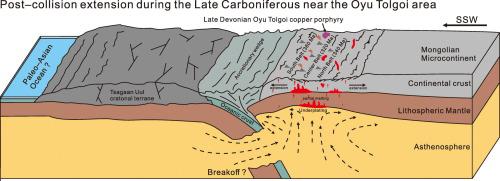当前位置:
X-MOL 学术
›
Gondwana Res.
›
论文详情
Our official English website, www.x-mol.net, welcomes your
feedback! (Note: you will need to create a separate account there.)
Multiphase Late Devonian to Carboniferous volcanic events in the west of Oyu Tolgoi, southeastern Mongolia: New geochronological, geochemical, and isotopic constraints on tectonic history
Gondwana Research ( IF 7.2 ) Pub Date : 2020-12-01 , DOI: 10.1016/j.gr.2020.08.008 Zejia Ji , Zhicheng Zhang , Baofu Han , Narantsetseg Tserendash
Gondwana Research ( IF 7.2 ) Pub Date : 2020-12-01 , DOI: 10.1016/j.gr.2020.08.008 Zejia Ji , Zhicheng Zhang , Baofu Han , Narantsetseg Tserendash

|
Abstract The Late Paleozoic volcanic rocks distributed in southeastern Mongolia are key to reconstructing the tectonic processes along the south margin of the Central Asian Orogenic Belt during this period. In this study, representative volcanic samples were collected in the west of Oyu Tolgoi near the eastern border of the South Gobi and Trans-Altai Zones. The geochronological results reveal intermittent Late Devonian to Early Carboniferous volcanic belts with zircon U Pb ages of 360, 320, and 340 Ma for the south, center, and north belts, respectively. Geochemical and isotopic results imply comparable petrogenesis for the samples from different belts. The basic samples are primarily derived from the different degrees of partial melting of a mantle source, and their compositions are slightly affected by the assimilation of crustal materials with different maturities. The intermediate to acidic samples were more likely produced by partial melting of a crust-derived source triggered by underplating of the mantle magma. The low Mg# and apparent Eu anomalies of the extremely high-Si rhyolites sampled from a bimodal-like volcanic sequence in the south belt indicate strong fractional crystallization after derivation from the partial melting of the juvenile crust. In conjunction with the spatiotemporal distribution pattern of magma and the observations recorded in previous studies, we propose that the Late Devonian to Early Carboniferous volcanic rocks from the south and north belts are a continental arc formed from the northward subduction of the Tsagaan Uul terrane under the Mongolian microcontinent and that the Late Carboniferous volcanism in the center belt was produced under a post-collision extensional setting. The subsequent increasingly intense extension was also responsible for the local Late Carboniferous to Early Permian calc-alkaline to alkaline granitic plutons.
中文翻译:

蒙古东南部奥尤陶勒盖西部多相晚泥盆世至石炭纪火山事件:构造历史的新地质年代学、地球化学和同位素约束
摘要 分布于蒙古东南部的晚古生代火山岩是重建这一时期中亚造山带南缘构造过程的关键。在这项研究中,在靠近南戈壁和跨阿尔泰地区东部边界的奥尤陶勒盖西部收集了具有代表性的火山样本。地质年代学结果揭示了断断续续的晚泥盆世至早石炭世火山带,南部、中部和北部带的锆石 U Pb 年龄分别为 360、320 和 340 Ma。地球化学和同位素结果意味着来自不同带的样品具有可比性的岩石成因。基本样品主要来自地幔源不同程度的部分熔融,它们的成分受不同成熟度地壳物质同化作用的影响较小。中间到酸性样品更有可能是由地幔岩浆底侵触发的地壳来源的部分熔融产生的。从南带双峰状火山层序中采集的极高硅流纹岩的低Mg#和明显的Eu异常表明来自幼年地壳部分熔融后强烈的分馏结晶。结合以往研究记录的岩浆时空分布格局和观测资料,我们认为南、北带晚泥盆世至早石炭世火山岩是蒙古微大陆下察干乌尔地体向北俯冲形成的大陆弧,中心带晚石炭世火山作用产生于- 碰撞扩展设置。随后越来越强烈的伸展也是造成当地晚石炭世到早二叠世钙碱性到碱性花岗岩岩体的原因。
更新日期:2020-12-01
中文翻译:

蒙古东南部奥尤陶勒盖西部多相晚泥盆世至石炭纪火山事件:构造历史的新地质年代学、地球化学和同位素约束
摘要 分布于蒙古东南部的晚古生代火山岩是重建这一时期中亚造山带南缘构造过程的关键。在这项研究中,在靠近南戈壁和跨阿尔泰地区东部边界的奥尤陶勒盖西部收集了具有代表性的火山样本。地质年代学结果揭示了断断续续的晚泥盆世至早石炭世火山带,南部、中部和北部带的锆石 U Pb 年龄分别为 360、320 和 340 Ma。地球化学和同位素结果意味着来自不同带的样品具有可比性的岩石成因。基本样品主要来自地幔源不同程度的部分熔融,它们的成分受不同成熟度地壳物质同化作用的影响较小。中间到酸性样品更有可能是由地幔岩浆底侵触发的地壳来源的部分熔融产生的。从南带双峰状火山层序中采集的极高硅流纹岩的低Mg#和明显的Eu异常表明来自幼年地壳部分熔融后强烈的分馏结晶。结合以往研究记录的岩浆时空分布格局和观测资料,我们认为南、北带晚泥盆世至早石炭世火山岩是蒙古微大陆下察干乌尔地体向北俯冲形成的大陆弧,中心带晚石炭世火山作用产生于- 碰撞扩展设置。随后越来越强烈的伸展也是造成当地晚石炭世到早二叠世钙碱性到碱性花岗岩岩体的原因。











































 京公网安备 11010802027423号
京公网安备 11010802027423号